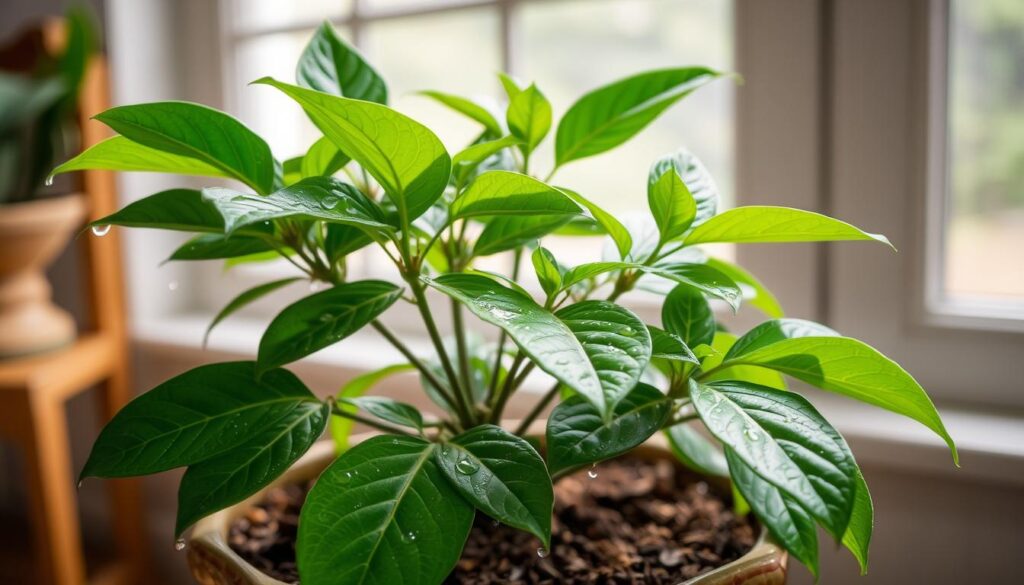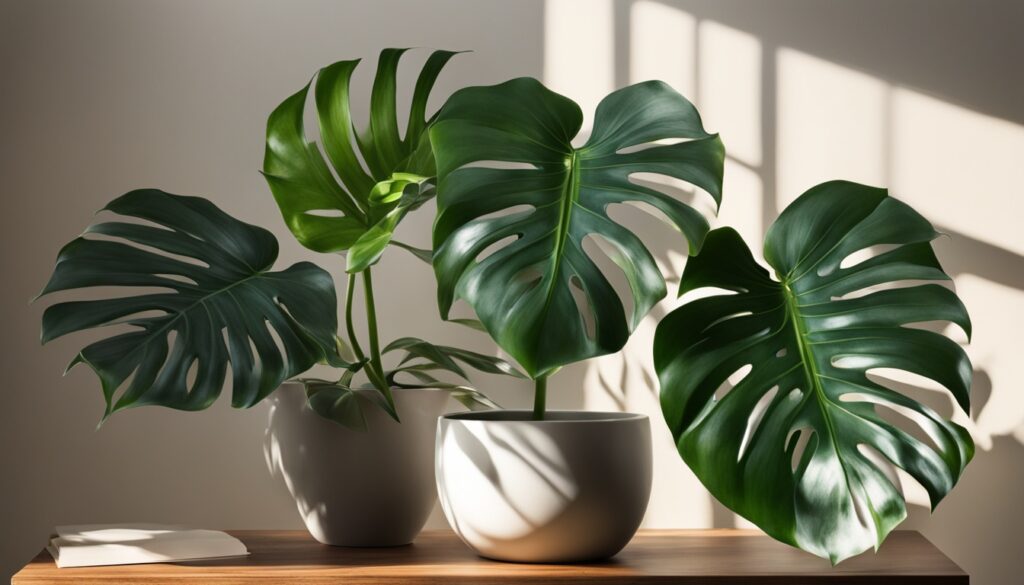Ready to keep your money tree thriving? The money tree is a symbol of prosperity and good fortune. It needs careful water care to reach its full potential. Learn the essential guidelines to make your money tree a financial growth powerhouse.
Key Takeaways
- Proper watering is crucial for the health and growth of money trees
- Money trees prefer to be on the dry side, with watering every 1-2 weeks
- Allowing the soil to mostly dry between waterings is recommended
- Overwatering is a common issue that can lead to problems like root rot
- Maintaining the right balance of moisture is key to nurturing your money tree’s wealth-attracting powers
Understanding the Money Tree: Origin and Symbolism
The Money Tree is a fascinating plant linked to prosperous investments and abundant liquid assets. It comes from the tropical wetlands of Central and South America. This plant can grow up to 60 feet tall in the wild, showcasing its natural wonder.
Cultural Significance and Feng Shui Connection
The Money Tree has deep cultural and spiritual value, especially in Feng Shui. It’s believed to draw in wealth, prosperity, and positive vibes. Its five-leaf shape stands for the five elements of Feng Shui, aiming for balance and abundance.
Natural Habitat and Growth Patterns
In the wild, Money Trees can grow over 60 feet tall. But indoors, they usually reach 1 to 8 feet. Their braided trunk and lush leaves make them a beautiful addition to any space.
Legend Behind the Lucky Plant
“The Money Tree’s legend tells the story of a man who discovered the easily propagated plant and cultivated it, leading to his prosperous investments and abundant liquid assets.”
This legend started in Taiwan in the 1980s. The plant’s link to wealth, luck, and fortune has grown worldwide. It’s now a symbol of financial success globally.
Money Tree Water: Essential Guidelines for Success
Proper watering is key for your money tree’s flourishing capital, known as Pachira aquatica. Water it every 1-2 weeks, letting the soil dry in between. Check the soil by sticking your finger in the pot to see if it’s time to water.
Use well-draining planters to avoid overwatering, which can cause root rot. Water until water comes out of the drainage hole. This ensures the soil is well-soaked. Money trees prefer dry soil. Water more often in spring and summer when they grow faster.
- Water money trees every 1-2 weeks, allowing the soil to dry between waterings.
- Use well-draining planters to prevent overwatering, a common mistake.
- Water until the liquid runs out of the drainage hole, ensuring thorough soaking.
- Adjust watering frequency based on the season, with more water during spring and summer.
By following these guidelines, your money tree will get the right water. This promotes its lucrative cash flow and health. Consistency is crucial for your money tree’s growth and success.
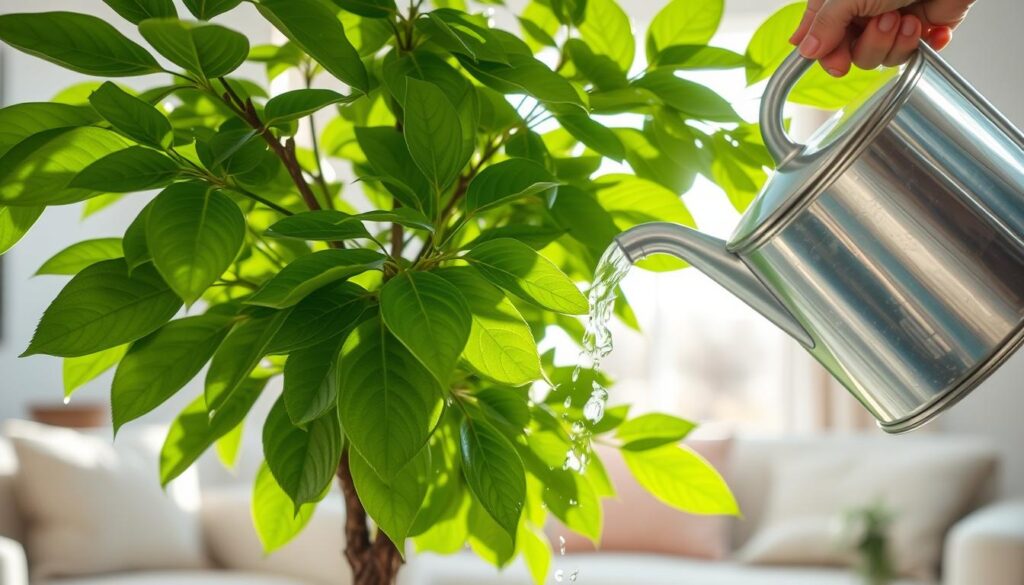
“Proper watering is the foundation for a thriving money tree, ensuring its long-term growth and financial symbolism.”
Creating the Perfect Growing Environment
To make sure your money tree grows well, you need to give it the right place to live. This includes the right temperature, humidity, and where to put it. Let’s look at what makes a money tree happy and healthy.
Temperature Requirements
Money trees like it warm, between 65-85°F (18-29°C). They do best in warmer places and can get stressed in cold or drafts. Keeping it in this warm range helps it grow well.
Humidity Levels and Management
Being from tropical places, money trees like it humid. Try to keep the humidity around 50% or more. You can use a humidity tray or humidifier. Also, having other plants nearby can help keep the air moist.
Ideal Location in Your Home
Put your money tree in a spot with bright, indirect light. This means near an east, west, or south window. But, avoid direct sunlight and drafty spots. Also, don’t place it near vents. Turning the plant often helps it grow evenly.
| Factor | Ideal Range |
|---|---|
| Temperature | 65-85°F (18-29°C) |
| Humidity | 50% or higher |
| Lighting | Bright, indirect |
| Placement | Near east, west, or south-facing window |
By giving your money tree the right temperature, humidity, and light, it will thrive. Remember, caring for it regularly is important. This way, your money tree will bring joy and beauty to your home.
Light Requirements for Optimal Growth
Proper light is key for your money tree’s health and growth. These plants love bright, indirect sunlight for 6-8 hours daily. They do well in light from east-, west-, or south-facing windows but not in dark spots.
To help your money tree grow, place it near a window that gets bright, indirect light. Avoid direct sunlight to prevent leaf scorch. If natural light is scarce, use artificial grow lights for 8-12 hours a day.
- Money trees can grow up to 6 feet tall indoors, needing bright, indirect light.
- Not enough light slows growth, makes leaves pale, and causes them to droop.
- Too much direct sunlight can turn leaves yellow and make them curl.
- Adjust the tree’s position seasonally to match changing light needs.
| Light Exposure | Ideal Duration | Impact on Growth |
|---|---|---|
| Bright, Indirect Sunlight | 6-8 hours daily | Optimal growth and financial growth |
| Moderate Light (North-facing Window) | 4-6 hours daily | Slower growth, potential for pale leaves |
| Direct Sunlight | Avoid | Leaf damage, discoloration, and curling |
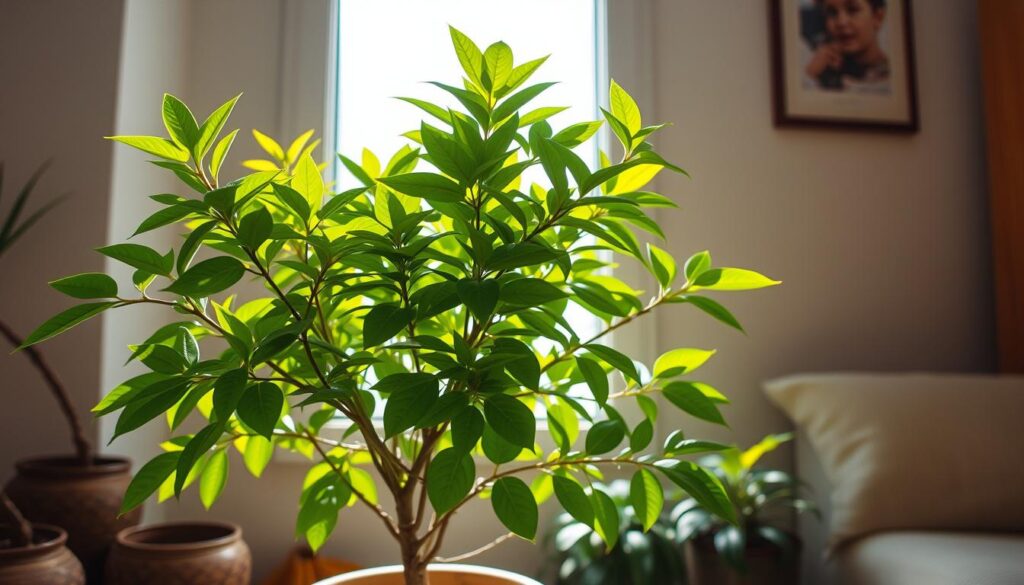
“Consistent light patterns are vital for Money Trees’ health, supporting their internal rhythms.”
By giving your money tree the right light, it will thrive. This supports its health and symbolizes financial growth.
Soil Selection and Drainage Importance
To make sure your Money Tree grows well, picking the right soil and drainage is key. Money Trees do best in soil that drains well and is rich in nutrients. This soil lets the roots breathe and keeps root rot away.
Best Potting Mix Components
The best potting mix for a Money Tree has both organic and inorganic parts. It should include:
- Peat moss or coco coir to keep moisture
- Perlite or sand for better drainage and air
- Compost or garden soil for nutrients
This mix holds some moisture but also lets water drain. It keeps the roots healthy and happy.
Drainage Solutions
For better drainage, use a pot with holes at the bottom. A pot that drains well stops water from staying too long. This prevents root rot and keeps your Money Tree healthy. Adding pebbles or gravel at the pot’s base helps with drainage and air.
| Soil Component | Benefit |
|---|---|
| Peat Moss | Retains moisture and improves soil structure |
| Perlite | Enhances drainage and aeration |
| Compost | Provides essential nutrients for plant growth |
“Proper soil selection and effective drainage are the foundation for a thriving Money Tree, ensuring its long-term wealth nurturing and prosperous investments.”
Seasonal Care Adjustments
Caring for your money tree, also known as Pachira Aquatica, means making smart changes all year. In spring and summer, water it more often and use a balanced fertilizer once a month. This helps it grow strong and green.
In fall and winter, water it less and stop using fertilizer. This lets the plant rest and prepare for the next growing season.
Keep your money tree in a spot with a steady temperature of 65-75°F (18-24°C). Don’t let it get too cold, as this can stress it out. When it starts growing again in spring, trim off any dead leaves. This encourages new growth and keeps it looking good.
“Proper seasonal adjustments are the key to keeping your money tree thriving and adding abundant liquid assets to your home decor.”
By following these tips, your money tree will stay healthy and bring good luck and wealth into your home.
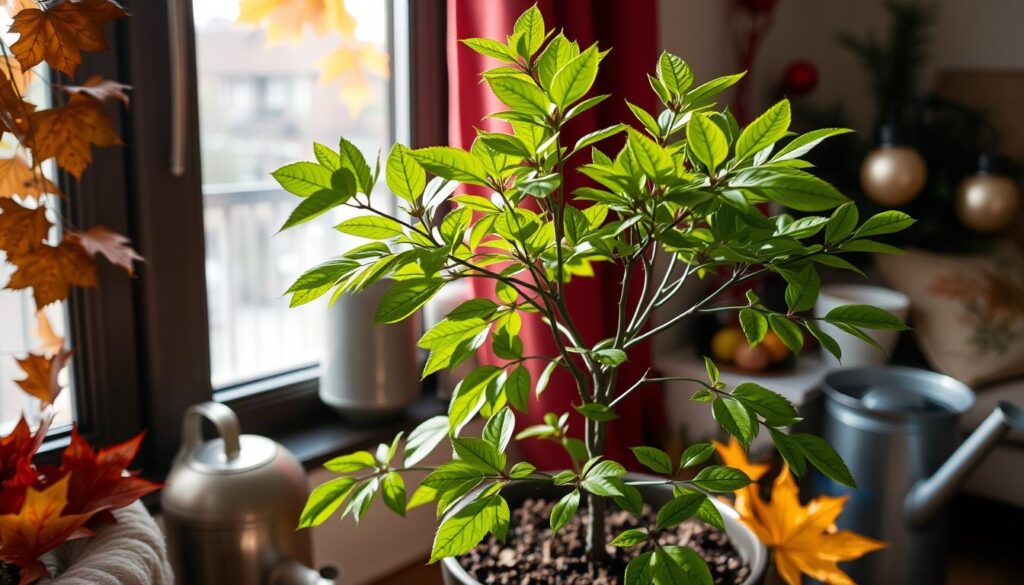
Signs of Improper Watering
Keeping the right amount of moisture is key for your money tree’s health. Too much or too little water can cause problems like yellow leaves or root rot. Let’s look at the signs to watch for and how to fix them.
Overwatering Symptoms
Overwatering is a common issue with money trees. Look for yellow, soft leaves, a bad smell from the soil, and root rot. If you see these, it’s time to change how you water your tree.
Underwatering Indicators
Not enough water can also harm your tree. Look for crispy, brown, or curled leaves. Check the soil often to catch this problem early.
Root Health Assessment
It’s important to check your tree’s roots for watering problems. Take the plant out of its pot and look at the roots. Healthy roots are firm and white. Bad roots are soft and brown. Change your watering to keep the roots healthy.
| Overwatering Symptoms | Underwatering Indicators |
|---|---|
| Yellowing leaves | Crispy, browning leaves |
| Soft, squishy trunk | Curling leaves |
| Foul soil odor | Wilting |
| Root rot | Stunted growth |
“Proper money tree irrigation is essential for maintaining the health and vitality of your plant. By understanding the signs of over- and under-watering, you can adjust your care practices to ensure your money tree thrives.”
Fertilization Schedule and Requirements
To keep your money tree healthy, you need to fertilize it right. In spring and summer, feed your money tree with liquid houseplant fertilizer every month. Use it at half strength to give your tree the nutrients it needs.
Don’t fertilize in fall and winter. The tree grows slower during these times. Too much fertilizer can harm the leaves or roots. So, stick to the schedule and use the right amount.
- The best fertilizer for Money Trees is Schultz 10-15-10 Plant Food Fertilizer. It has 10% nitrogen, 15% phosphorus, and 10% potassium.
- If your tree gets a lot of light, fertilize it every month. For medium light, do it four times a year. And for low light, fertilize once or twice a year.
- It’s important to mix the fertilizer with water correctly. This prevents damage to your plant.
- The best time to fertilize for blooming is late spring to early summer. This matches the tree’s growth phase.
If you’ve recently repotted your money tree, wait a month before fertilizing. This lets the plant settle into its new home. By doing this, you give your money tree the nutrients it needs to grow well and stay healthy.
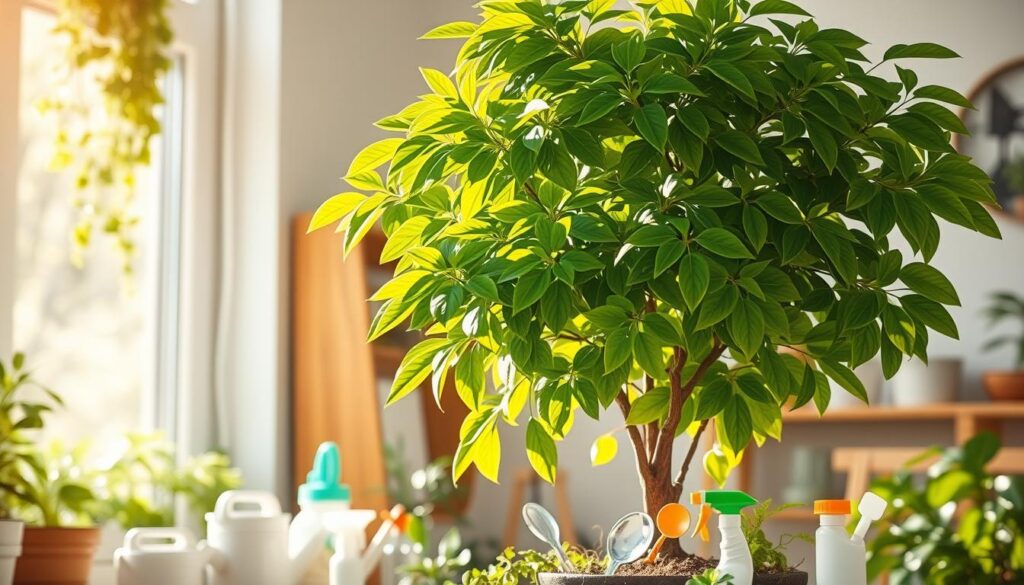
“Proper fertilization is essential for the overall health and vitality of your money tree. By following a balanced schedule and using the right product, you can help your plant reach its full potential.”
Common Problems and Solutions
Maintaining a thriving Money Tree requires vigilance and addressing common issues proactively. From pest infestations to disease prevention, understanding the signs and implementing suitable solutions can help ensure the financial growth and wealth nurturing of your cherished plant.
Pest Management
Money Trees can fall victim to various pests, including spider mites, aphids, and mealybugs. Signs of an infestation may include sticky residue on the leaves, stippled foliage, and stunted growth. Treat these pests with a gentle, eco-friendly solution like insecticidal soap or neem oil, taking care to thoroughly cover all affected areas.
Disease Prevention
Proper care and maintenance are crucial to preventing diseases in Money Trees. Avoid overwatering, which can lead to root rot, and maintain optimal humidity levels to stave off fungal infections. If a disease does arise, isolate the affected plant and remove any damaged leaves. Treat with the appropriate fungicides to restore your Money Tree’s health and vitality.
| Common Money Tree Issues | Symptoms | Diagnosis | Solutions |
|---|---|---|---|
| Overwatering | Yellowing leaves, wilting, leaf drop | Soggy soil, mushy roots | Reduce watering, improve drainage, repot in a grittier mix |
| Underwatering | Crispy leaves with brown edges, dry soil | Extremely dry soil | Establish a regular watering schedule, incorporate peat moss |
| Root Rot | Yellow leaves, decaying smell, mushy roots | White, soft, and decaying roots | Trim dead roots, improve drainage, avoid overwatering |
| Pests | Tiny critters, webbing, sticky leaves | Identify the specific pests | Use neem oil or insecticidal soap |
| Nutrient Deficiency | Sad, yellow leaves, slow growth | Specific symptoms related to nutrient deficiencies | Provide a balanced fertilizer, target missing nutrients |
| Environmental Stress | Browning, wilting, or curling leaves | Evaluate light, temperature, and humidity levels | Find the right balance of environmental factors |
By understanding the common problems and implementing the appropriate solutions, you can ensure the financial growth and wealth nurturing of your beloved Money Tree.
Pruning and Maintenance Techniques
To keep your money tree healthy and looking good, you need to prune it regularly. Prune in the spring to shape the plant and help it grow well. Cut off any dead, damaged, or crossing branches to keep it balanced and looking great.
When you prune, use sharp shears to make clean cuts just above a node. This encourages new growth, making your money tree fuller. Don’t over-prune or remove all leaves at once. This can stress the plant and slow its growth.
- Thinning cuts and heading cuts are commonly used for pruning money trees.
- When removing an entire branch, leave about an inch to prevent damage to the trunk.
- Sanitize your pruning tools before and after use to prevent the spread of disease.
- Prune in late winter or early spring when the money tree is actively growing.
- Avoid over-pruning, which can remove more than one-third of the plant and cause stress.
Pruning wisely keeps your money tree healthy and looking good. By following these tips, your money tree will stay a valuable addition to your space. It will keep your air clean and look beautiful.
| Pruning Technique | Description | Benefit |
|---|---|---|
| Thinning Cut | Remove entire branches at the trunk or main stem | Promotes better light penetration and air circulation |
| Heading Cut | Trim the ends of branches to encourage lateral growth | Creates a bushier, more compact plant |
| Node Cut | Prune just above a leaf node, about 1/2 inch from the branch | Stimulates new branch development |
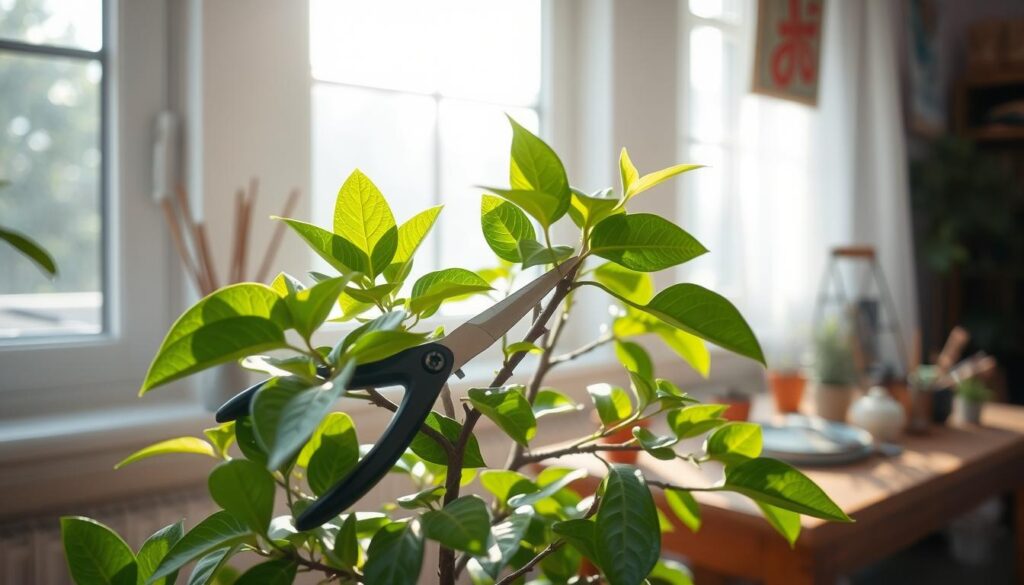
“Proper pruning is essential for maintaining the health and shape of your money tree. With the right techniques, you can ensure your plant remains a prosperous investment for years to come.”
Understanding the Braided Trunk Care
The Money Tree, also known as the Braided Money Tree, is loved for its lucrative cash flow and flourishing capital. Its braided trunk is not natural but comes from careful cultivation. Learning to braid and care for the Money Tree’s trunk is key to its health and long life.
Braiding Techniques
Braiding the Money Tree’s trunks is a delicate task. It starts when the plant is young and the stems are soft. As the tree grows, the braiding needs to be adjusted to fit the expanding trunk. This means gently moving new growth into the braid without harming the plant.
Maintenance Tips
- Start braiding the Money Tree’s stems when it’s small and the stems are soft.
- Check the braid often and adjust the ties as the trunk grows to avoid damage.
- Move new growth into the braid carefully to keep the design looking good.
- Remember, braiding is optional and doesn’t affect the plant’s health or lucrative cash flow.
By following these tips, Money Tree lovers can keep their plant’s braided trunk looking stunning. This makes it a beautiful centerpiece, adding to its flourishing capital.
https://www.youtube.com/watch?v=emCAXs1c68c
“The Money Tree’s braided trunk is a symbol of good fortune and prosperity, making it a popular choice for homes and offices seeking to cultivate a lucrative cash flow.”
| Braiding Tip | Benefit |
|---|---|
| Start braiding when the plant is young | Allows the braid to grow and develop naturally with the plant |
| Adjust ties as the trunk expands | Prevents damage and maintains the intricate braid pattern |
| Gently manipulate new growth | Keeps the braid looking neat and well-maintained |
| Braiding is optional | Does not affect the plant’s overall health or flourishing capital |
Growth Patterns and Expectations
Indoor Money Trees can grow up to 6-8 feet tall. Their growth rate depends on care and environment. They grow faster in spring and summer, producing new leaves.
As the plant ages, some leaves may turn yellow and fall off. With the right money tree irrigation, these plants can live over a decade. They offer fruitful funding streams of prosperity and good fortune.
Understanding Money Tree growth helps in caring for them. This ensures a healthy, vibrant plant. It adds positive energy to your space. With proper care, your Money Tree becomes a symbol of inspiration and growth.
